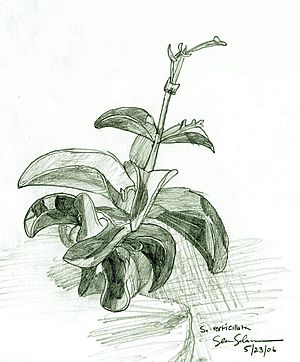Schiedea verticillata facts for kids
Quick facts for kids Schiedea verticillata |
|
|---|---|
 |
|
| Artist's rendition of Nihoa carnation; note triangular-shaped leaves | |
| Conservation status | |
| Scientific classification | |
| Genus: |
Schiedea
|
| Species: |
verticillata
|
The Nihoa carnation (scientific name: Schiedea verticillata) is a very special and rare plant. It is also sometimes called the Devils Slide schiedea. This plant is a type of carnation, but it doesn't look exactly like the carnations you might see in a flower shop.
It belongs to the plant family Caryophyllaceae. This unique plant only grows on one small island called Nihoa. Nihoa is part of the Northwestern Hawaiian Islands. Scientists first found the Nihoa carnation in 1923 during a trip called the Tanager Expedition. Since 1996, it has been listed as an endangered species. This means it is at high risk of disappearing forever.
Contents
What Does the Nihoa Carnation Look Like?
The Nihoa carnation has stems that can grow about 40–60 cm (16–24 in) long. These stems can stand up straight or sometimes trail along the ground. Its leaves are a fresh mint-green color and can be as long as 15 cm. They are also quite fleshy.
The flowers of the Nihoa carnation are interesting because they don't have petals like many other flowers. Instead, they have ten stamens, which are the parts that produce pollen. They also have 4 or 5 styles, which are part of the plant's reproductive system.
Life Cycle and Survival
The Nihoa carnation has a clever way to survive in its dry home. During the dry season, the plant seems to die back. This process is called aestivation. But it's not really dead! It just shrinks down to its fleshy perennial roots, which stay alive underground. When the rainy season returns, the plant grows back from these roots.
Today, fewer than 400 individual Nihoa carnation plants exist. They live in just two rocky valleys on Nihoa Island. Even though there are so few plants, their population has stayed pretty stable.
How Does It Reproduce?
Scientists are still not sure how this plant is pollinated. This means they don't know exactly how its pollen is moved from one flower to another to help it make seeds.
Even with such a small number of plants, the Nihoa carnation is quite strong. It has a high amount of genetic diversity. This means there is a good variety in its genes, which helps the plants stay healthy and adapt. This is important because it helps the Nihoa carnation avoid a problem called inbreeding. Inbreeding happens when plants that are too closely related reproduce, which can lead to weaker plants. Another plant from Nihoa, Amaranthus brownii, faces this problem, but the Nihoa carnation has enough genetic variety to avoid it.
See also
 In Spanish: Clavel Nihoa para niños
In Spanish: Clavel Nihoa para niños


